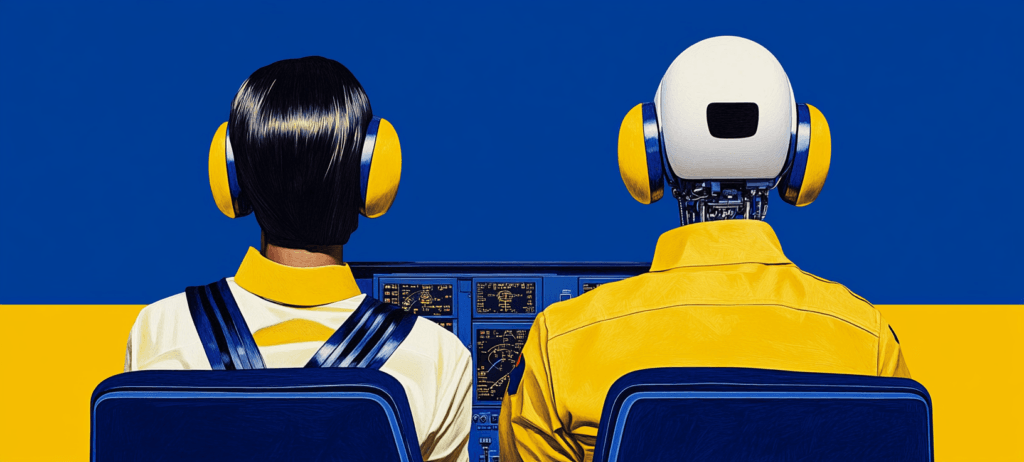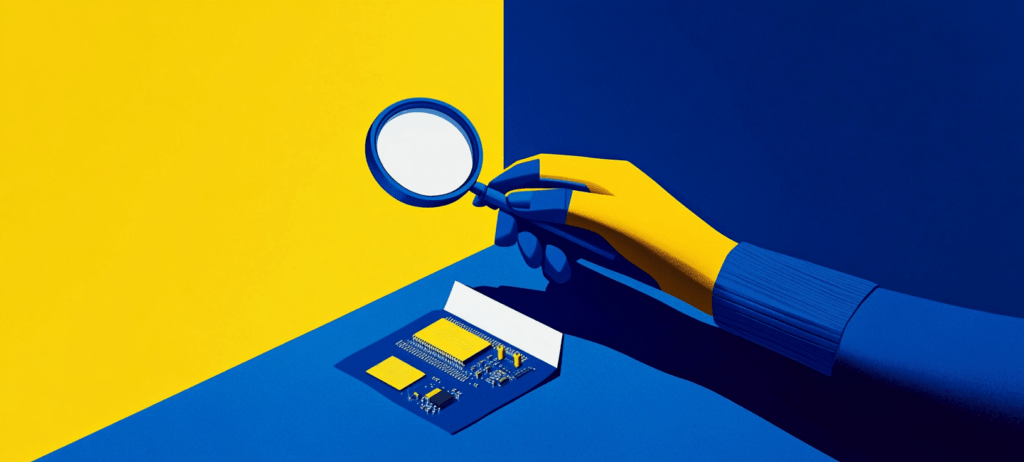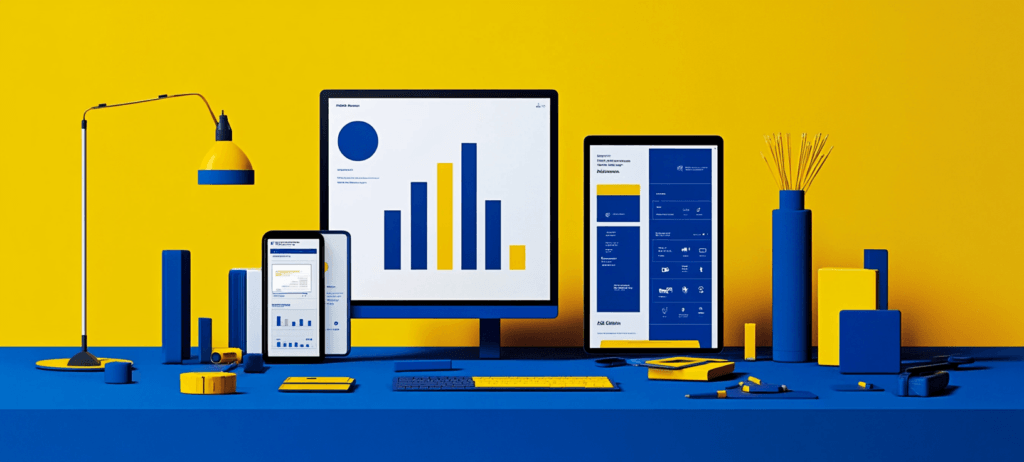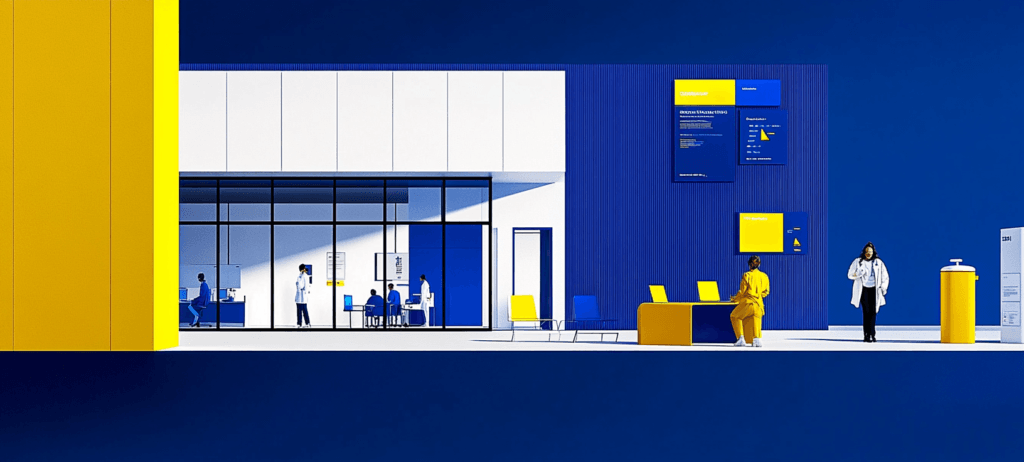-
 Published: Apr 16, 2025
Published: Apr 16, 2025
-
 6 min. read
6 min. read
-
Summarize in ChatGPT
-
 Celeste Yates
Celeste Yates Content Writer
Content Writer
- Celeste has worked in the online marketing space for twenty years. She has written for sectors including tourism, sustainability, education, lifestyle, food, and marketing. You can find her work featured by Green Building Media South Africa, Stodels Gardening, and The Post House Hotel. In magazines, you may have seen her in The Cape Times, Oprah South Africa, and The Property Magazine. While you can find her writing up on the latest SEO trends and exploring digital techniques during the day, her love of story-telling carries on in enriched games and books after hours.
In April 2024, Microsoft officially announced the addition of Copilot to the Microsoft Ads platform. This addition gives marketers and advertisers new access to Microsoft Ads AI, helping them create, monitor, and improve their campaigns automatically.
Since that initial announcement, Microsoft has announced new ad types, advancements, and tools, all to help you manage your campaigns in 2025 and beyond.
To help you leverage AI in your Microsoft Ads, we’ll look into the basics of Microsoft Ads AI below:
- What is Microsoft Ads?
- What is Microsoft Copilot?
- How does Microsoft Ads AI work?
- Applications of Microsoft Ads AI
- Microsoft Ads AI vs. Google Ads AI
- Future applications of Microsoft Ads and Copilot

Key Takeaways on Microsoft Ads and Copilot
- Copilot uses conversational AI to help advertisers create and manage ad campaigns.
- Microsoft AI automatically recommends text and image assets based on a landing page or campaign details.
- Copilot in Microsoft Ads can generate custom images for ad campaigns tailored to the user’s prompts.
- The generative AI platform in Microsoft Ads offers tools to iterate and refine ad copy and images, allowing businesses to adjust tone, style, and branding in real time.
What is Microsoft Ads?
Formerly known as Bing Ads, Microsoft advertising is a platform that allows businesses to place ads across Microsoft’s ecosystem. These platforms include a wide range of categories and areas on the Internet, including:
- Search results: Microsoft will display your ads on Yahoo and Bing.
- Connected TV (CTV): A few spaces include Netflix, Samsung, and Roku.
- Business network: You can display your ads through Microsoft advertising on LinkedIn.
You can use a mix of different types of mediums for your ads, such as images, video, or multimedia. You can target your audience within the platform with custom segmentation and location-based targeting, similar to Google Ads.
What is Microsoft Copilot?
Microsoft Copilot is an AI-driven assistant that enhances productivity and creativity through a conversational language model. The technology is embedded in several Microsoft programs, including Microsoft 365 tools such as Word, PowerPoint, and Outlook. It is also available in more specialized areas, such as Microsoft’s advertising platform.
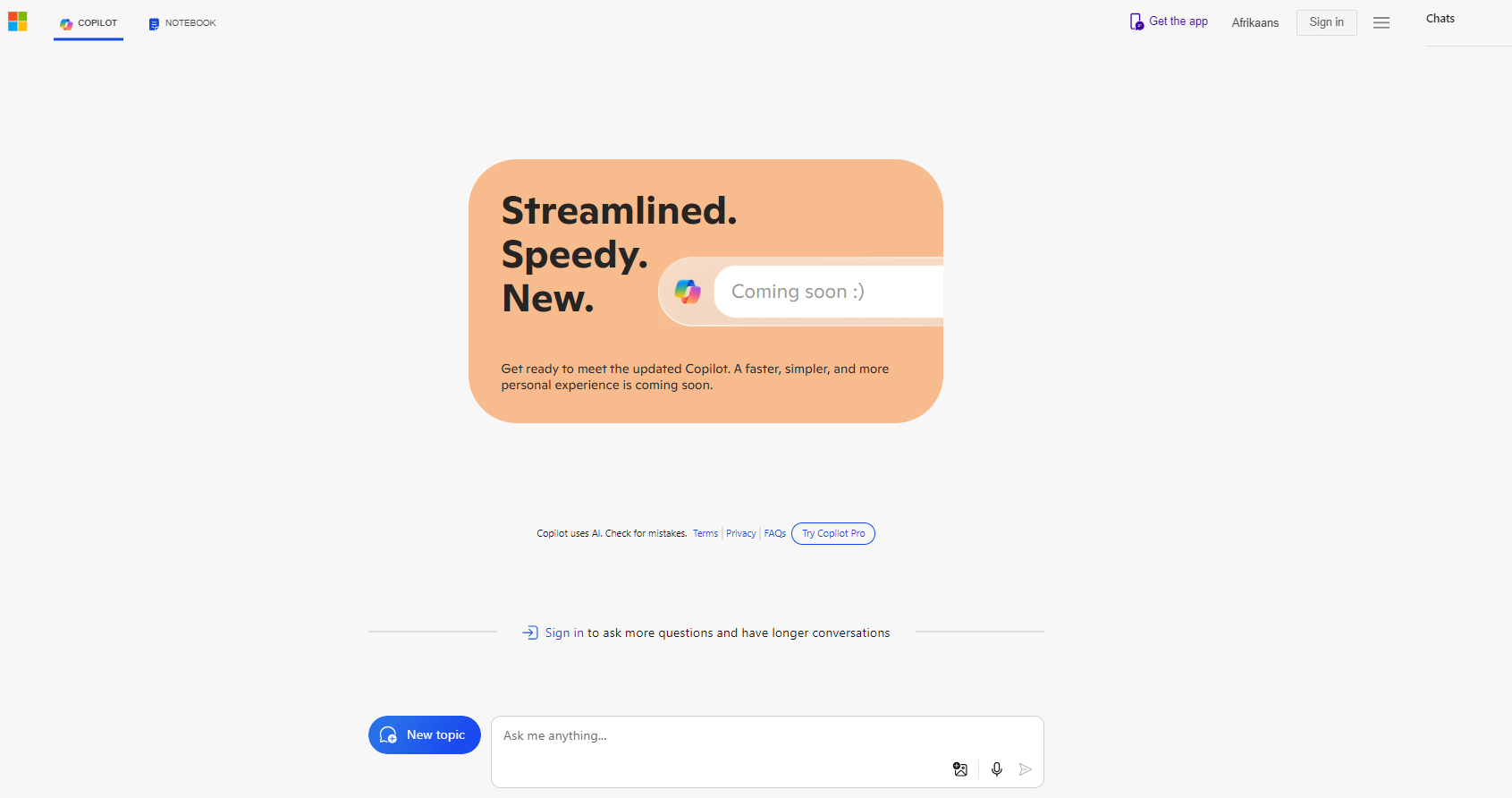
It includes general natural language processing (NLP) technology to generate personalized and context-aware outputs. You can engage with it by asking questions or providing prompts for it to respond to and refine its results based on your feedback.
How does Microsoft Ads AI work?
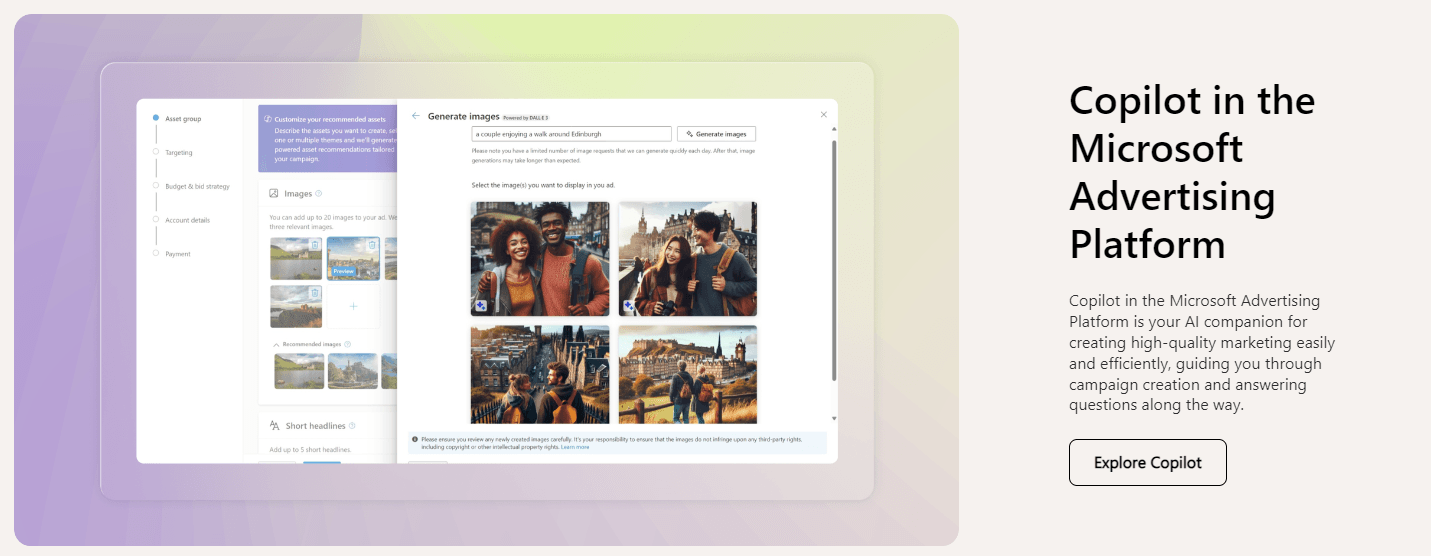
Microsoft Ads AI (powered by Copilot) uses generative AI to help advertisers create, optimize, and analyze their campaigns. You can use the tool in various ways to accomplish different marketing and ad creation tasks.
Below are the features of Copilot in the Microsoft Ads interface:
- Conversational chat for ad creation: Copilot can act as a conversational assistant that helps users create ad campaigns. It can answer questions in real-time and guide them through the process of setting up campaigns.
- Asset recommendations: During campaign creation, Copilot can recommend text and image assets based on the advertisers’ landing page URLs. Thus, you can quickly populate your ads with relevant content and images.
- Image and video creation: Copilot’s AI can also generate custom campaign images and videos from text inputs. The tool integrates with Designer to generate ad visuals with prompts. Marketers can also access AI background removal, seasonal theme customization, and even video ad creation for social and CTV ads.
- Multichannel and omnichannel campaigns: Copilot allows advertisers to manage their omnichannel advertising efforts from a single platform by optimizing them for different channels. Advertisers using Microsoft Cloud can feed data into Ads, allowing for better synergy between AI in Ads and Microsoft CRM tools.
Applications of Microsoft Ads AI
So, how can marketers use Microsoft Ads AI? There are plenty of ways, and companies are already testing them. According to one Microsoft case study, Softchoice used Copilot to create marketing materials more than 60% faster.
Some general marketing use cases of Microsoft Ads AI include:
- Creating email subject lines and content
- Drafting blog posts
- Creating ad campaign timelines
- Measuring campaign performance
- And more!
This AI technology can apply one idea or concept across different industries, tones, jargon, personas, and platforms. For example, here are a few different industries that could benefit from this emerging technology:
- Ecommerce: Copilot can recommend product-specific text and image assets tailored to ecommerce campaigns, such as shopping ads for retail items. It can generate relevant product descriptions and personalize suggestions based on user behavior.
- Travel and hospitality: By creating highly seasonal, time-sensitive campaigns, Copilot can recommend that travel companies adjust promotional content to align with trends.
- Financial services: For financial institutions, you can generate ads that respond to fluctuating market conditions and combine it with user behavior. With AI-powered diagnostics, you can adjust your campaigns in real-time to reflect economic trends or regulatory changes.
Microsoft Ads AI vs. Google Ads AI
What makes Microsoft Ads AI different from the other platforms? Let’s compare Copilot with Google AI and see some differences:
| Feature | Microsoft Ads AI | Google Ads AI |
|---|---|---|
| AI Copywriting | ✅ | ✅ |
| Conversational Chat Interface | ✅ | ❌ |
| CTV Ad Creation | ✅ | ❌ |
| AI Image Generator | ✅ | ✅ |
Learn More: Google Ads vs. Bing Ads
Future applications of Microsoft Ads and Copilot
As Microsoft continues to integrate AI deeply into its advertising ecosystem, we can expect more sophisticated personalization capabilities to develop. Copilot is already helping advertisers tailor content to their audiences, and this is likely to evolve further with more real-time dynamic adjustments to ad creatives and targeting.
Here are a few future trends and applications to watch for with Microsoft Ads AI:
Deeper Integration with Copilot
Microsoft is aligning its advertising platform more closely with the Copilot AI assistants used in Microsoft 365, Bing, Edge, and Windows.
We can expect to see unified Copilot interfaces along with cross-platform audience insights. This might look like blending ad data with customer behavior in Teams, Outlook, or Dynamics.
Stronger privacy and ethical AI commitments
As scrutiny of AI increases, Microsoft is investing in content provenance, watermarking, and labeling of AI-generated ads. They also will prioritize AI bias mitigation to ensure fair targeting and ad delivery.
AI will also require consent, meaning more transparent opt-in systems for advertisers and users.
AI-driven small business campaign creation
Microsoft is pushing hard on making advertising easier for small businesses using natural language campaign setup. Instead of manually planning their campaign, they can use AI tools for entire projects.
This small-business targeting can also lead to auto-generated ad groups, keywords, and creatives from a URL or product feed.
Looking to grow your online advertising?
These advertising platforms can be powerful tools for your business—if you know how to use them effectively. If you need help, don’t stress. WebFX is here for you! As a full-service agency, we simplify the process by handling everything in-house, creating a customized advertising strategy that sets your brand apart.
Request your free proposal today or contact us at 888-601-5359.
-
 Celeste has worked in the online marketing space for twenty years. She has written for sectors including tourism, sustainability, education, lifestyle, food, and marketing. You can find her work featured by Green Building Media South Africa, Stodels Gardening, and The Post House Hotel. In magazines, you may have seen her in The Cape Times, Oprah South Africa, and The Property Magazine. While you can find her writing up on the latest SEO trends and exploring digital techniques during the day, her love of story-telling carries on in enriched games and books after hours.
Celeste has worked in the online marketing space for twenty years. She has written for sectors including tourism, sustainability, education, lifestyle, food, and marketing. You can find her work featured by Green Building Media South Africa, Stodels Gardening, and The Post House Hotel. In magazines, you may have seen her in The Cape Times, Oprah South Africa, and The Property Magazine. While you can find her writing up on the latest SEO trends and exploring digital techniques during the day, her love of story-telling carries on in enriched games and books after hours. -

WebFX is a full-service marketing agency with 1,100+ client reviews and a 4.9-star rating on Clutch! Find out how our expert team and revenue-accelerating tech can drive results for you! Learn more
Try our free Marketing Calculator
Craft a tailored online marketing strategy! Utilize our free Internet marketing calculator for a custom plan based on your location, reach, timeframe, and budget.
Plan Your Marketing Budget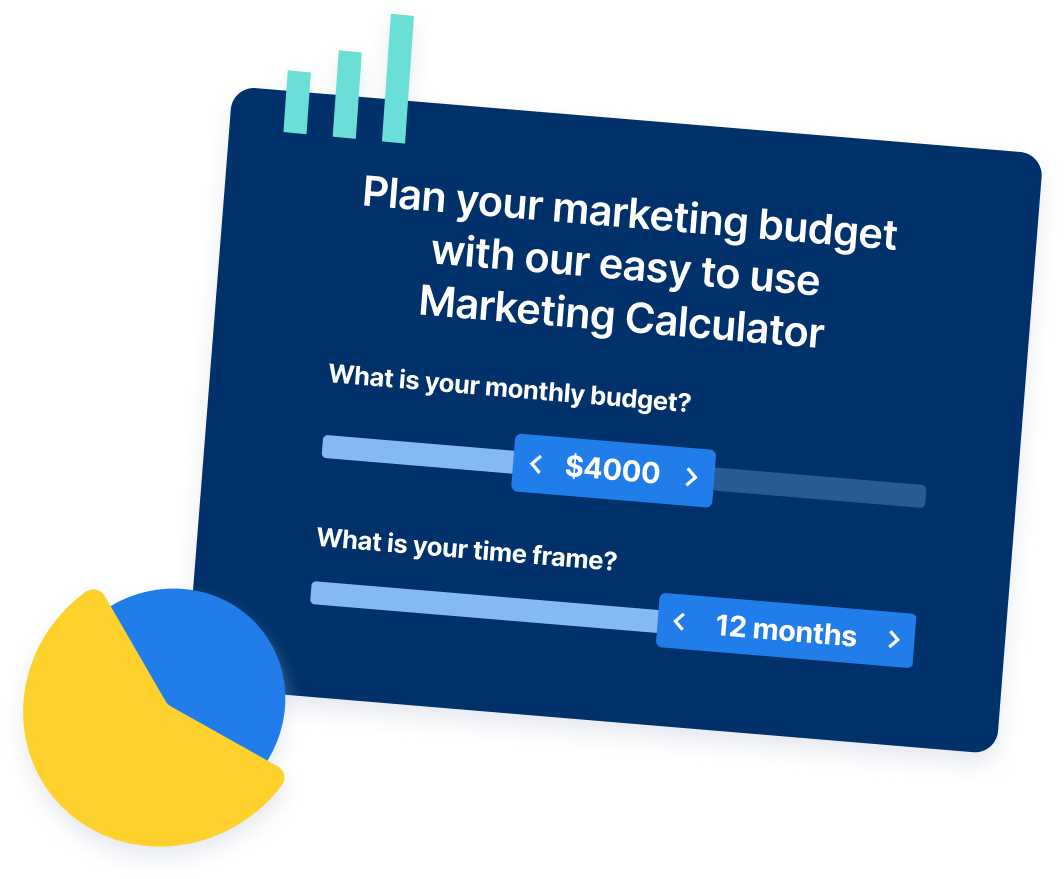

See AI Marketing in Action
Explore how WebFX helped a regional brand get discovered in AI search experiences — proving what’s possible with today’s AI-driven marketing!

Proven Marketing Strategies
Try our free Marketing Calculator
Craft a tailored online marketing strategy! Utilize our free Internet marketing calculator for a custom plan based on your location, reach, timeframe, and budget.
Plan Your Marketing Budget
